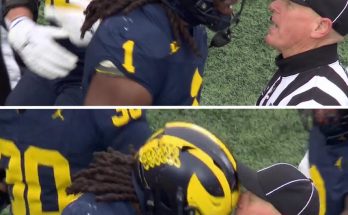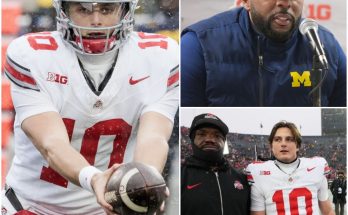BREAKING: Texas Shake-Up — RB Jerrick Gibson and K Will Stone Exit Longhorns, Both Set to Enter Transfer Portal
The college football landscape is never short on drama, and in Austin, the latest chapter has just been written. Texas is reeling from breaking news that running back Jerrick Gibson and kicker Will Stone have both officially left the program and plan to enter the NCAA transfer portal. The news, first reported by On3Sports and later confirmed by reporter Anwar Richardson, has sent waves through Longhorn Nation, stirring deep conversations about depth, development, and direction as the season rolls on.
For a program that entered the year with high expectations and a “championship or bust” mentality, this midseason shake-up could not have come at a more crucial time. The departure of two scholarship players—especially Gibson, a former blue-chip prospect—raises pressing questions about player management, team chemistry, and the balance between talent retention and competitive culture in one of the most scrutinized college programs in America.
Jerrick Gibson’s decision to leave may sting most for Texas fans. Once a prized recruit and part of Steve Sarkisian’s much-heralded 2024 class, Gibson was viewed as a future cornerstone in the Longhorns’ backfield. Rated as one of the top running backs in his class, he arrived in Austin with the reputation of being explosive, dynamic, and ready to make an impact in a system tailor-made for versatile runners. His departure, therefore, isn’t just about depth—it’s symbolic of a broader issue that many elite programs face in the modern era of college football: the delicate balance between opportunity, patience, and the ever-present lure of the transfer portal.
When Gibson first committed to Texas, the vision was clear. Sarkisian saw him as part of a deep and talented running back rotation that could compete with the best in the SEC once Texas makes the full transition to the conference. With his combination of speed, vision, and pass-catching ability, Gibson fit perfectly into the offensive scheme. But as the season progressed, opportunities were limited. The Longhorns’ backfield, led by more experienced players, left little room for Gibson to showcase his skills consistently.
For many young athletes today, waiting one’s turn isn’t always easy—especially when the transfer portal provides instant access to programs in need of immediate help. Gibson’s decision underscores that tension. It’s not necessarily about dissatisfaction or disloyalty; it’s about maximizing potential and seizing a chance to play. In today’s college football ecosystem, where every snap and every highlight can define a player’s future, sitting on the bench can feel like watching time slip away.
Meanwhile, kicker Will Stone’s exit may not command the same level of national attention, but it’s equally significant for the Longhorns’ special teams unit. Stone, who had been with the program since the 2022 season, offered reliability and depth in a position that often doesn’t get the spotlight—until something goes wrong. His departure leaves a gap in the kicking competition and forces Texas to re-evaluate its special teams plans moving forward.
Kickers rarely make headlines, but they often define moments. Stone’s consistency, preparation, and quiet professionalism were valued inside the locker room. His choice to leave midseason may reflect the same reality Gibson faces: fierce internal competition, limited opportunities, and the new college football reality where players can move freely to find the best fit.
For Texas, the timing of these departures adds another layer of complexity. With the season deep into its grind and every game carrying playoff implications, roster stability becomes paramount. Losing players—especially ones with the potential to contribute down the stretch—can disrupt practice rotations, affect morale, and test the leadership within the locker room.
Head coach Steve Sarkisian now finds himself in a familiar position for modern college coaches: navigating the unpredictable waters of roster turnover in real time. It’s a challenge unique to the transfer portal era. Gone are the days when depth charts remained fixed for an entire season. Now, coaches must constantly manage not just performance on the field, but also player satisfaction off it.
To his credit, Sarkisian has built a culture rooted in communication, honesty, and accountability. He has emphasized the importance of developing players both on and off the field, but the competitive nature of elite programs often means not everyone can play right away. When a player like Gibson—talented but waiting behind established contributors—sees limited action, the temptation to seek a new beginning elsewhere becomes understandable.
Still, the optics matter. Texas fans, already anxious about maintaining momentum and avoiding distractions, may interpret the news as a potential crack in the armor. Yet, in truth, the Longhorns are far from unique in this regard. Programs across the nation—Alabama, Georgia, Ohio State, and USC included—have faced similar midseason departures as players reassess their roles and futures.
The transfer portal, now a permanent fixture in the sport, has changed everything. It’s a double-edged sword: a platform that empowers athletes to find the right fit, but one that also forces programs to constantly re-recruit their own rosters. For coaches, it’s no longer enough to land five-star talent; the challenge lies in keeping that talent engaged, developed, and bought into the vision, even when playing time is scarce.
In Gibson’s case, several factors could have contributed to his decision. Depth in the backfield, combined with Texas’ offensive rotation and play-calling tendencies, likely limited his touches. The Longhorns’ offensive identity has leaned heavily on balance and experience, with the coaching staff often favoring proven veterans in high-pressure situations. For a young player eager to showcase his ability, the path to consistent playing time can feel blocked.
As for Will Stone, the dynamics within the special teams room may have shifted as well. Whether it was competition from younger kickers or a desire for a fresh start elsewhere, Stone’s decision speaks to the individuality of player journeys in this era. Each athlete weighs different priorities—playing time, development, coaching relationships, or even proximity to home—and the transfer portal provides the flexibility to act on those needs immediately.
The broader implication for Texas lies in what comes next. Losing two players midseason is not ideal, but it’s also an opportunity to reassess depth, reaffirm leadership, and reinforce the team’s focus. The Longhorns have prided themselves on resilience, and this moment will test that. Sarkisian’s staff must now lean on its player development philosophy and locker-room leadership to maintain unity.
From a recruiting perspective, however, this could send mixed signals. Prospective players are always watching how programs handle departures. The key for Texas will be in transparency—acknowledging that while the transfer portal era brings turnover, it also reflects the program’s depth and the competitiveness that comes with it. In a sense, losing talented players can be a sign of just how strong a roster truly is.
For the fanbase, the reactions have been mixed. Some see the exits as part of the natural churn of modern college football—inevitable, even. Others worry that it hints at dissatisfaction behind the scenes. Social media has been buzzing with speculation, but the program’s response has been measured. There’s an understanding that player movement is part of the new normal, and panic serves no one.
The most immediate question, though, is where Gibson and Stone will land. With Gibson’s talent and pedigree, he will likely attract interest from numerous Power Five programs. His versatility makes him a fit in multiple offensive systems, particularly those emphasizing open-field speed and pass-catching backs. Stone, on the other hand, could find a new home quickly, as reliable kickers are always in demand—especially among programs seeking stability in special teams play.
Their next destinations will be closely followed, but for now, Texas must focus on the present. The Longhorns still have their season goals ahead of them, including the pursuit of a conference title and potential playoff contention. Sarkisian’s challenge will be ensuring that this off-field distraction doesn’t derail the on-field mission.
In truth, moments like these can either fracture a team or forge it stronger. The best programs use adversity as fuel. Veteran leaders in the locker room—captains, seniors, and trusted voices—will play an essential role in reinforcing the culture that Sarkisian has tried to build. It’s about reminding everyone that the logo on the helmet still means something, regardless of who suits up on Saturday.
For Texas, this episode also serves as a reminder that building a championship team in the modern era isn’t just about recruiting elite talent—it’s about retaining it. Development, communication, and a sense of belonging have become just as important as schemes and playbooks. Coaches must coach the person as much as the player.
As the Longhorns regroup, the message will be simple: next man up. It’s the mantra of competitive programs everywhere, and it’s one that Texas must embrace once again. Losing players hurts, but it also opens doors for others to step forward, to seize their chance, and to prove that the team’s identity remains intact.
When the dust settles, these midseason exits may ultimately serve as a footnote rather than a turning point. Yet, they reflect the undeniable truth of today’s college football environment—one where movement is constant, loyalty is complex, and opportunity reigns supreme.
For Jerrick Gibson and Will Stone, this marks the beginning of a new chapter. For Texas, it’s another test of culture, depth, and adaptability. And for college football fans everywhere, it’s a reminder that in this era of change, no program, no matter how prestigious, is immune from the ripple effects of the portal.
The Longhorns will march on. But their path, as always, will be shaped not only by those who stay—but also by those who choose to go.



